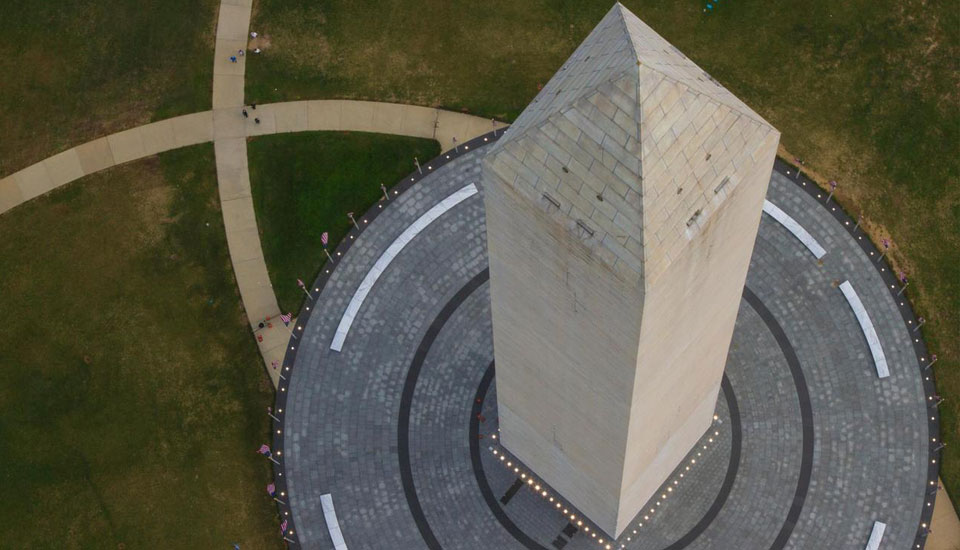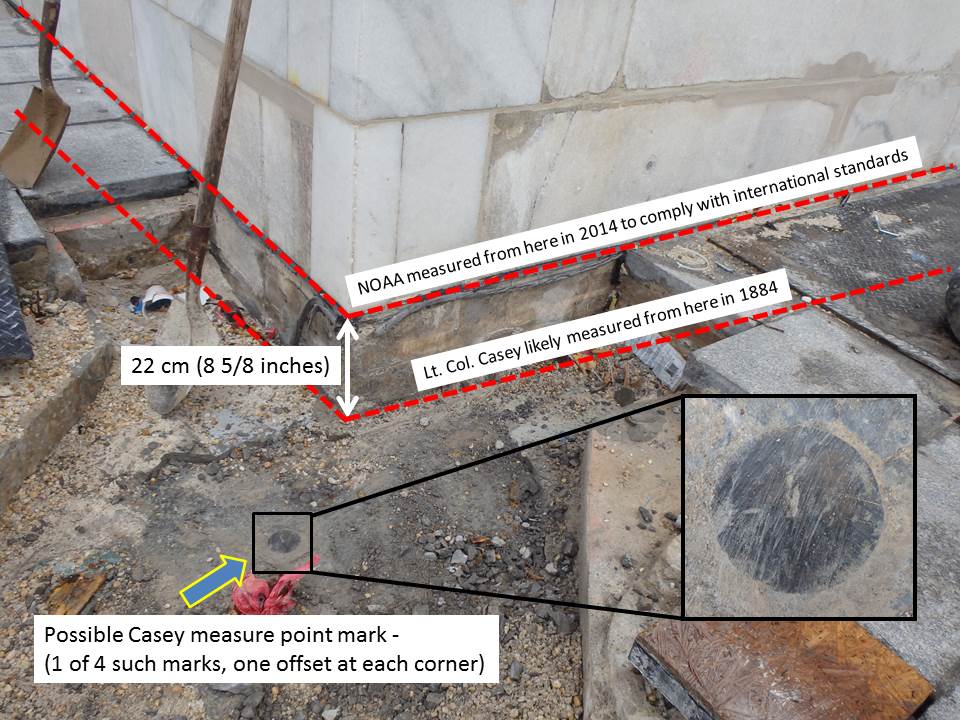NOAA Study Uses Latest Tech to Compute Updated Washington Monument Height
Obelisk's architectural elevation measurement now meets international standards.

A Tall Order
A unique view of the Washington Monument from the National Park Service. Using new international measurement standards and technology not available in the past, NOAA's National Geodetic Survey has calculated the official architectural height of the Washington Monument to be 554 feet 7 11/32 inches—a highly precise measurement that makes it eligible for inclusion in official registers of the world's tallest structures.

Illustration of the measuring points used by Lt. Col. Thomas Casey in 1884 and the 2014 measuring point used by NOAA to meet Council on Tall Buildings and Urban Habitats (CTBUH) standards. Download
Using new international measurement standards and technology not available in the past, NOAA's National Geodetic Survey has calculated the official architectural height of the Washington Monument to be 554 feet 7 11/32 inches—a highly precise measurement that makes it eligible for inclusion in official registers of the world's tallest structures. NOAA's NGS provides the framework for all positioning activities in the nation.
The NGS measurement was made using measuring certification standards of the Council on Tall Buildings and Urban Habitats (CTBUH) and was finalized in December 2014. The final results were reported to the National Park Service in a report that will be available online beginning February 17.
Although the newly established architectural height differs from the historical height of 555 feet 5⅛ inches, neither the starting point nor the so-called "standard deviation" used for the original 1884 measurement is known, making comparison of the two measurements difficult. The new architectural height provides baseline documentation that can be easily reproduced for comparison with future measurements and investigations to determine if the height of the monument is changing in any way.
The new elevation standard meets the requirements to nominate the monument for inclusion on the register of the world's tallest structures as maintained by the CTBUH. The council recently certified the new One World Trade Center in New York City as the tallest building in the Western Hemisphere at 1,776 feet, and as the third tallest completed building in the world. The council provides the global measuring certification standards for official structure height.
"Data gathered through science and technology are continually teaching us more about our planet and our history," said Kathryn Sullivan, Ph.D., under secretary of commerce for oceans and atmosphere and NOAA administrator. "NOAA's National Geodetic Survey's authoritative spatial data, models, and tools are vital for the protection and management of our nation's natural and manmade resources. We are pleased to join with the National Park Service in caring for special places like the Washington Monument and in discovering more about its treasures."
"The National Park Service appreciates the results of our continued partnership with NOAA's National Geodetic Survey and look forward to fully evaluating the report's findings of the architectural height of the Washington Monument," said Karen Cucurullo, NPS acting superintendent of National Mall and Memorial Parks. "The data from collaborative projects such as this provide us additional tools with which to track changes and plan appropriate measures for the long-term preservation of the monument."
"We have to be cautious in comparing this new height to the historic one, since we do not know precisely the actual starting point that U.S. Army Corps of Engineers Lt. Col. Thomas Casey used in 1884," said NOAA's Dru Smith, Ph.D., NOAA's chief geodesist. "Today's elevation reflects the international standards for measurement of a building's height as well as considerable technological improvements."
With the earthquake repair scaffolding in place in 2012, NOAA and the NPS worked cooperatively to update the position of the peak of the monument--its latitude, longitude, and elevation--as well as to determine the architectural height of the building, a "base-to-tip" height that for the first time would meet modern international standards for building heights.
The resulting architectural height of 554 feet 7 11/32 inches is accurate to within plus or minus one-thirty second of an inch, or one millimeter. That variation is what is known as the "standard deviation" and can help explain the changing height estimates over the years.
"No measurements are perfect," said Smith. "What is important to know is how well that measurement has been made – the standard deviation. We do not know the standard deviation used in the original estimate of 555 feet 5⅛ inches, nor do we know the actual starting point for the measurement."
"It is the reference to an eighth of an inch that makes the original measurement so interesting," Smith said. "Did the original builders think they had truly measured or estimated the height with sufficient accuracy to justify that last eighth of an inch? The answer is unclear and at present remains lost to history. What we can now say with certainty is that the current height can be definitively stated to be within the standard deviation."
The 2013-14 survey and architectural height is the end result of a request from the NPS to determine if the August 23, 2011, earthquake had caused any unexpected settling of the Monument which suffered extensive cracking of its stonework. Based on a post-earthquake leveling survey done in 2012, NGS determined the earthquake "had no discernible impact on the settlement of the Washington Monument."
As part of that same 2012 survey, NGS further found that the rate of settlement for the Washington Monument itself, based on multiple measurements taken since 1901, is two-hundredths of an inch per year. This indicates that the monument has settled just under 2¼ inches since 1901, none of which is attributable to the 2011 earthquake.
The just completed 2013-2014 survey included leveling to the base of the monument and verified the 2012 findings. However, the modern standard for measurement of the architectural height of the Monument refers to the height up to the tip of the monument measured from the actual floor point within the Monument itself, and not to a point or points on or below the ground around the building. The source of the original height may have come from four markers, dubbed "the Casey Marks" located in the ground a few feet off each of the Monument's corners that NGS discovered in its 1999 survey of the Monument which basically reconfirmed the Casey original report of 555 feet 5⅛ inches.
NGS in the latest survey also measured the height from those marks, which do not conform to the newer international standards for building elevation measures, and matched the 1885 height to within ¾ of an inch. No other mark or marks on or near the monument comes as close as that to serving as a suitable "zero height." There remains, however, no historical evidence in anything Casey reported that he did indeed use those corner marks as his zero height point.